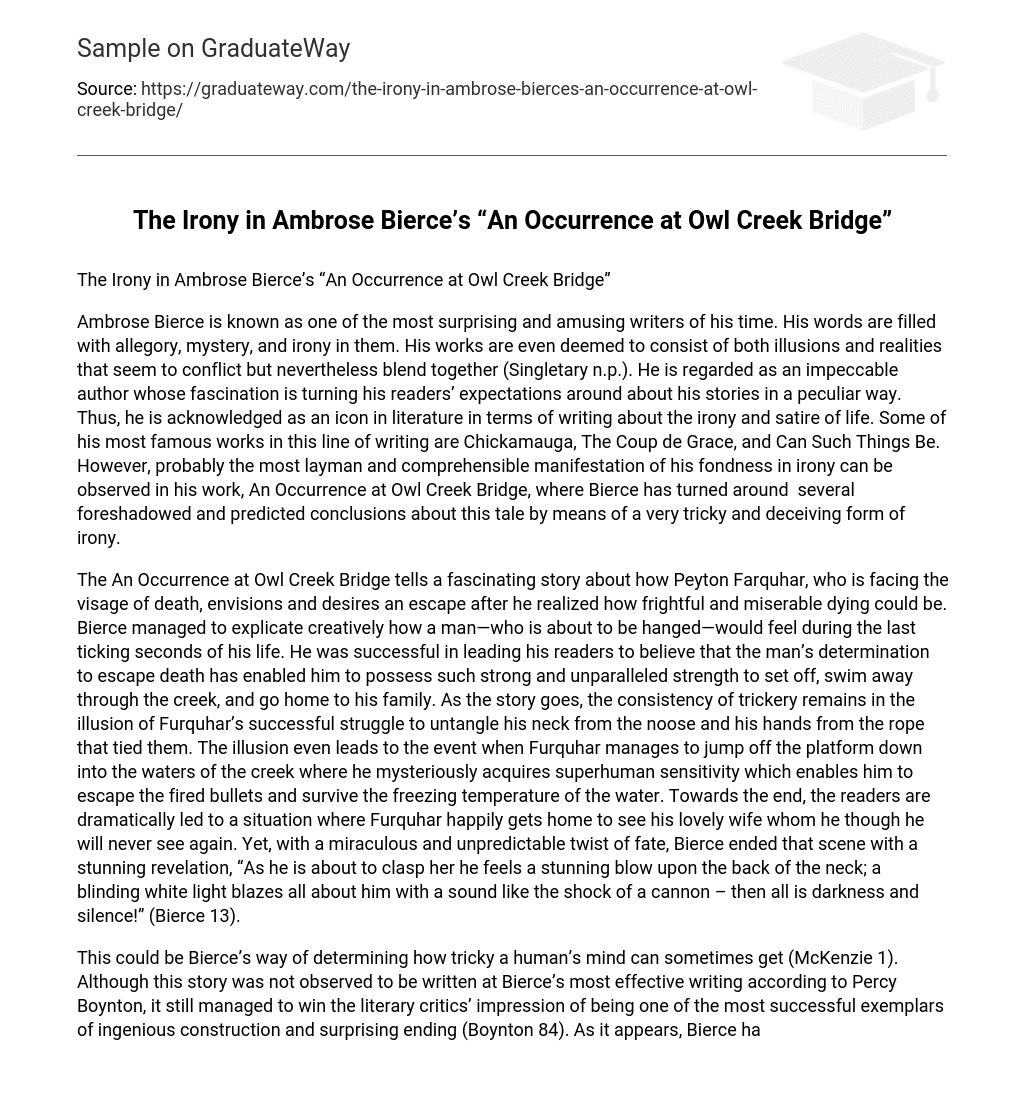Ambrose Bierce is known as one of the most surprising and amusing writers of his time. His words are filled with allegory, mystery, and irony in them. His works are even deemed to consist of both illusions and realities that seem to conflict but nevertheless blend together (Singletary n.p.). He is regarded as an impeccable author whose fascination is turning his readers’ expectations around about his stories in a peculiar way. Thus, he is acknowledged as an icon in literature in terms of writing about the irony and satire of life. Some of his most famous works in this line of writing are Chickamauga, The Coup de Grace, and Can Such Things Be. However, probably the most layman and comprehensible manifestation of his fondness in irony can be observed in his work, An Occurrence at Owl Creek Bridge, where Bierce has turned around several foreshadowed and predicted conclusions about this tale by means of a very tricky and deceiving form of irony.
The An Occurrence at Owl Creek Bridge tells a fascinating story about how Peyton Farquhar, who is facing the visage of death, envisions and desires an escape after he realized how frightful and miserable dying could be. Bierce managed to explicate creatively how a man—who is about to be hanged—would feel during the last ticking seconds of his life. He was successful in leading his readers to believe that the man’s determination to escape death has enabled him to possess such strong and unparalleled strength to set off, swim away through the creek, and go home to his family. As the story goes, the consistency of trickery remains in the illusion of Furquhar’s successful struggle to untangle his neck from the noose and his hands from the rope that tied them. The illusion even leads to the event when Furquhar manages to jump off the platform down into the waters of the creek where he mysteriously acquires superhuman sensitivity which enables him to escape the fired bullets and survive the freezing temperature of the water. Towards the end, the readers are dramatically led to a situation where Furquhar happily gets home to see his lovely wife whom he though he will never see again. Yet, with a miraculous and unpredictable twist of fate, Bierce ended that scene with a stunning revelation, “As he is about to clasp her he feels a stunning blow upon the back of the neck; a blinding white light blazes all about him with a sound like the shock of a cannon – then all is darkness and silence!” (Bierce 13).
This could be Bierce’s way of determining how tricky a human’s mind can sometimes get (McKenzie 1). Although this story was not observed to be written at Bierce’s most effective writing according to Percy Boynton, it still managed to win the literary critics’ impression of being one of the most successful exemplars of ingenious construction and surprising ending (Boynton 84). As it appears, Bierce has succeeded in creating a deceiving narrator and a disillusioned series of events (Palisano n.p.) Truly, if a reader was not radical and critical enough, he or she would not easily realize that the events of Furquhar’s escape are rather impossible and unlikely to take place. Thus, Bierce can be considered as a master of this style—a master who uses such a powerful irony to make sure his readers think carefully and radically as they go through each scene of the story. This talent of turning the readers’ illusions around was attributed by Bierce’s critics to his magnificent ability of manipulating the elements of the story such as the language, time, and perspective (Palisano). Thus, reading and re-reading Bierce’s masterpiece just proves one thing: He is indeed one of the few literary satirists who can twist a lot of predicted and foreseen endings through such a very illusory and deceiving form of irony.
Works Cited
Bierce, Ambrose. An Occurrence at Owl Creek Bridge. Forgotten Books, 2008.
Boynton, Percy H. More Contemporary Americans. New Hampshire: Ayer Company Publishers, Inc., 1967.
McKenzie, Alley. “An Occurrence at Owl Creek Bridge: An Analysis.” Associated Content. Art and Entertainment. 28 October 2008. 18 February 2009 <http://www.associatedcontent.com/article/1142020/an_occurrence_at_owl_creek_bridge_an.html?cat=2>.
Palmisano, Joseph. “An Occurrence at Owl Creek Bridge, Ambrose Bierce: Introduction.” Enotes. 2006. 18 February 2009 <http://www.enotes.com/short-story-criticism/
an-occurrence-owl-creek-bridge-ambrose-bierce>.
Singletary, Stacey Ann. “Ambrose Bierce, 1842-1914.” Univeristy of North Carolina at Pembroke. 18 February 2009 <http://www.uncp.edu/home/canada/work/allam/18661913/lit/bierce.htm>.





